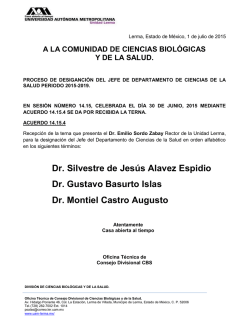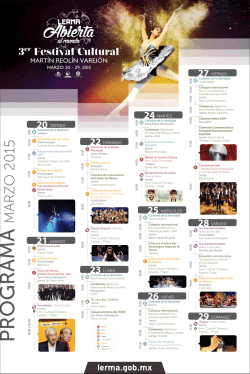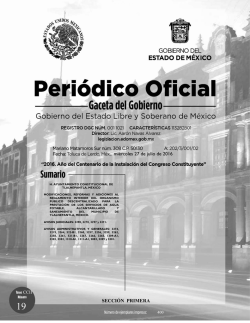
Folleto Vive la Historia. Parador de Lerma
Vive la Historia Live the History PARADOR DE LERMA El palacio de Lerma es el edificio principal de uno de los proyectos urbanísticos más importantes de su época. Junto a él, varios conventos, una gran plaza y los enormes jardines aterrazados sobre el Arlanza hicieron de esta ciudad una artificial y efímera corte del Barroco español. The Palace of Lerma is the main building of one of the most important urban projects of its epoch. Beside it there are several convents, a large square and the enormous terraced gardens over the River Arlanza made this city an artificial and ephemeral court of the Spanish Baroque period. El nuevo y gran palacio que proyectó el duque, valido de Felipe III, aprovechó el antiguo castillo medieval de Lerma y fue encomendado a Francisco de Mora, arquitecto del rey. Fue construido en sucesivas fases: primero, en 1602, se adaptó el castillo, para posteriormente, en una segunda fase (1613-16) construirse una nueva edificación anexa, junto a la fachada norte. En una última fase (1616 -18) ambas casas fueron unificadas dándole el aspecto actual, quedando la primera casa-castillo encajada dentro. Tal complejidad es apenas visible en el resultado final de un edificio con planta rectangular y la disposición típica de los palacios castellanos del XVII: un gran patio central rodeado de galerías arcadas del que arranca una amplia escalera de piedra. En el exterior, el contraste entre la piedra y la cubierta de pizarra le da un aire escurialense realzado por las cuatro torres esquineras con chapiteles. En su sencilla fachada de dos pisos con vanos adintelados sólo destaca la puerta principal rematada por un frontón curvo y, sobre ella, un amplio balcón flanqueado por dos escudos ducales. La sobriedad arquitectónica ocultaba un rico y suntuoso interior que albergaba la espléndida colección del duque de Lerma, una de las más importantes de la Europa del siglo XVII. The grand, new palace planned by the Duke, the royal favourite of King Felipe III, took advantage of the ancient medieval castle of Lerma and entrusted the building to Francisco de Mora, the king’s architect. It was built in successive phases: in the first in 1602 the castle was adapted and, subsequently, in a second phase (1613-16) a new annexed building was built beside the north façade. In a final phase (1616-18), both houses were joined, to give it its current aspect, with the first house-castle fitted inside. This complexity is scarcely visible in the final result of a building with a rectangular design and the typical layout of the Castilian palaces of the XVII century: a large central patio surrounded by arched galleries where a wide stone stairway starts. In the exterior, the contrast between the stone and the slate roof gives it an air similar to the Escorial enhanced by the four corner towers spire. The only outstanding part of the simple two floor façade with lintel like hollows is the main door finished off by a by a curved pediment and, over this a wide balcony flanked by two ducal coats of arms. The architectural sobriety concealed a rich and sumptuous interior which housed the splendid collection of the Duke of Lerma, one of the most important of in Europe in the XVII century. EL DUQUE DE LERMA, VALIDO REAL Durante veinte años fue el hombre más poderoso de España. Valido real desde 1599, trasladó la corte a Valladolid por cinco años (1601-1606) para reducir el poder de sus enemigos de Madrid convirtiendo a Lerma en estratégica por su cercanía a la nueva corte. Cuando cayó en desgracia en 1618 su villa y palacio fueron condenados al olvido. El duque de Lerma ha pasado a la historia como ejemplo de concentración de poder, corrupción y nepotismo en un siglo de gravísima crisis económica y política. Con él empezaba la política del valimiento real que no era más que la dejación de funciones por parte del monarca en manos de un hombre fuerte que, como en este caso, tuvo a su disposición todos los resortes del poder. El propio Felipe II antes de morir tuvo miedo de la influencia que Lerma podía ejercer sobre su hijo, el joven y voluble futuro Felipe III, y le alejó de la corte. Fue en vano porque, tras la muerte del rey, Gómez de Sandoval volvió a Madrid y empezó a ejercer veinte años de poder absoluto dominando al nuevo monarca y acumulando, a base de favores y escándalos, una de las mayores fortunas de su tiempo. Aprobó la firma de una tregua de paz de doce años con los Países Bajos y la expulsión de los moriscos, ambos en 1609, considerados los dos acontecimientos más importantes de su valimiento. THE DUKE OF LERMA, THE ROYAL FAVOURITE PEDRO PABLO RUBENS, El duque de Lerma (Museo Nacional del Prado) Categoría: Palacio Fecha: 2003 Arquitecto: Carlos Fernández-Cuenca BIC: Monumento Category: Palace Date: 2003 Architect: Carlos Fernández-Cuenca BIC (Property of Cultural Interest): Monument For twenty years, he was the most powerful man in Spain. The Royal Favourite since 1599, he transferred the Court to Valladolid for five years (1601-1606) in order to weaken the power of his enemies in Madrid, converting Lerma into a strategic point due to its proximity to the new Court. When he fell into disgrace in 1618, his town and palace were condemned to oblivion. The Duke of Lerma has passed into history as an example of the concentration of power, corruption and nepotism in a century which witnessed a very serious economic and political crisis. He began the policy of royal favouritism which was none other than the abandonment of the functions of the monarch in the hands of a strong man who, as in this case, had all the resources of power at his disposal. Before dying, King Felipe II was afraid of the influence which Lerma might influence over his son, the young and fickle Felipe III, and he cast him out of the Court. This was in vain as, after the death of the king, Gómez de Sandoval returned to Madrid and began to exercise absolute power for twenty years, dominating the new monarch and accumulating one of the largest fortunes of his time through favours and scandals. He approved the signing of a Peace Treaty with the Netherlands for twelve years and the expulsion of the Moriscos (Muslim converts to Christianity). Both of these occurred in 1609, and are considered to be the two most important events of his time as Royal Favourite. LA VIRGEN EN EL TRONO En el parador se exhibe una talla considerada una de las piezas más valiosas de la colección artística de Paradores por su antigüedad (s. XIV) y su gran tamaño. Se trata de una virgen de una sola pieza estucada, policromada y dorada de estilo flamenco. Su estilo de transición se evidencia en el contraste entre el hieratismo de su pose frontal frente al naturalismo de su expresión. Los ángeles que sostienen la corona son posteriores, probablemente, del siglo XVIII. THE VIRGIN ON THE THRONE A carving is exhibited in the Parador and is considered to be one of the most valuable pieces of the artistic collection of Paradores due to its antiquity (XIV century) and its large size. It is a figure of Our Lady made in a single, polychromatic gilded plaster piece in the Flemish style. Its transitional style is evident in the contrast between stateliness of its frontal pose as compared to the naturalism of its expression. The angels who hold the crown are posterior, probably from the XVIII century. TAMBIÉN LE GUSTARÁ: YOU WILL ALSO LIKE THE FOLLOWING: Conjunto palacial de Lerma: plaza ducal, colegiata de San Pedro, pasadizo del duque, conventos y barrio medieval. The Palace Complex of: Ducal Palace, Collegiate of San Pedro, The Duke’s Passage, convents and medieval district
© Copyright 2025




